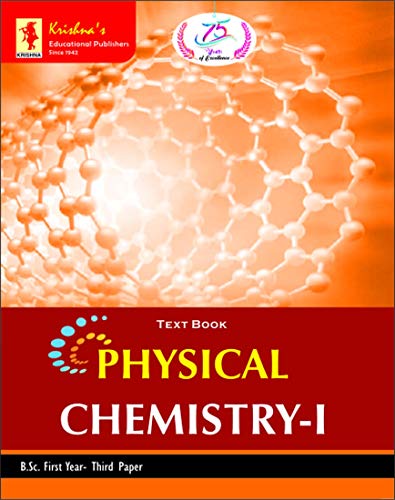
English | 2021 | ASIN: B094B5JKBF | 266 pages | PDF | 3.43 MB
input-output devices; binary numbers and arithmetic's; introduction to computer
languages, programming, operating systems.
UNIT-II
2. Gaseous States: Postulates of kinetic theory of gases, deviation from ideal behavior, Van der Waals
equation of state; Critical Phenomena: PV isotherms of real gases, continuity of states, the
isotherms of Van der Waals equation, relationship between critical constants and Van der Waals
constants, the law of corresponding states, reduced equation of state. Molecular velocities: Root
mean square, average and most probable velocities, Qualitative discussion of the Maxwell's
distribution of molecular velocities, collision number, mean free path and collision diameter,
Liquification of gases (based on Joule " Thomson effect).
3. Liquid State: Intermolecular forces, structure of liquids (a qualitative description). Structural
differences between solids, liquids and gases; Liquid crystals: Difference between liquid crystal, solid
and liquid, Classification, structure of nematic and cholestric phases, Thermography and seven
segment cells.
UNIT-III
4. Solid States: Definition of space lattice, unit cell; Laws of crystallography " (i) Law of constancy of
interfacial angles, (ii) Law of rationality of indices (iii) Law of symmetry, Symmetry elements in
crystals. X-ray diffraction by crystals, Derivation of Bragg equation, Determination of crystal
structure of NaCl, KCl and CsCl (Laue's method and powder method).
5. Colloidal States: Definition of colloids, classification of colloids; Solids in liquids (sols): properties "
kinetic, optical and electrical; stability of colloids, protective action, Hardy-Schulze law, gold number.
Liquids in liquids (emulsions) : types of emulsions, preparation, Emulsifier, Liquids in solids (gels) :
classification, preparation and properties, inhibition, general application of colloids, colloidal
electrolytes.
UNIT-IV
6.Chemical Kinetics and Catalysis: Chemical kinetics and its scope, rate of a reaction, factors
influencing the rate of a reaction"concentration, temperature, pressure, solvent, light catalyst,
concentration dependence of rates, mathematical characteristics of simple chemical reactions"zero
order, first order, second order, pseudo order, half life and mean life, Determination of the order of
reaction"differential method, method of integration, method of half life period and isolation method.
Radioactive decay as a first order phenomenon; Experimental methods of chemical kinetics:
conductometric, potentiometric, optical methods, polarimetry and spectrophotometer. Theories of
chemical kinetics: effect of temperature on rate of reaction, Arrhenius equation, concept of
activation energy. Simple collision theory based on hard sphere model, transition state theory
(equilibrium hypothesis), Expression for the rate constant based on equilibrium constant and
thermodynamic aspects. Catalysis, characteristics of catalysed reactions, classification of catalysis
homogeneous and heterogeneous catalysis, enzyme catalysis, miscellaneous examples.
download скачать
https://nitroflare.com/view/EED4B6529219354/z891g.Krishnas..Physical.Chemistry.I.Edition3.pdf
https://rapidgator.net/file/bfa98d80c3132d95325587953aa8c1c1/z891g.Krishnas..Physical.Chemistry.I.Edition3.pdf

